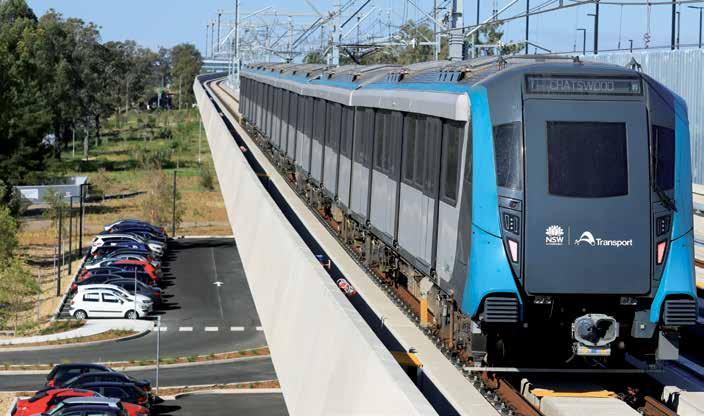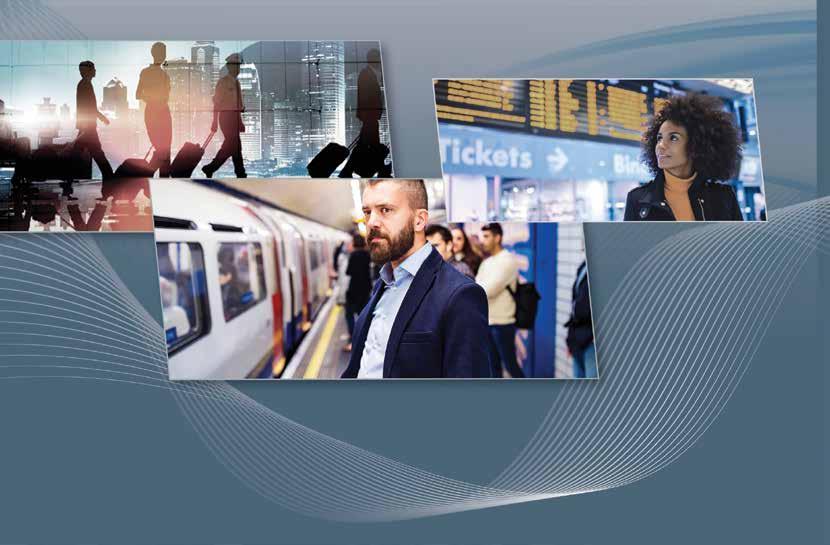
11 minute read
New South Wales & ACT
from REX Aug 2019
ACT scoping Woden redevelopment ahead of light rail build
LIGHT RAIL WON’T CARRY passengers to the south Canberra district of Woden for several years, but it’s already driving change, with the ACT Government scoping the relocation of a key training campus to align with the transport project.
ACT transport minister and minister for vocational education and skills Meegan Fitzharris said in June – just before she announced she was stepping away from politics – that the Government was investigating a major investment which would relocate the Canberra Institute of Technology (CIT)’s Reid campus to Wen Town Centre.
Fitzharris said the project would help create a new, modern, purpose-built campus and be a major anchor for the revitalisation of Woden.
“CIT is the premier [skills] provider in the Canberra region; delivering world class vocational education and training to more than 20,000 students every year,” Fitzharris said.
“Positioning CIT with a major presence in the heart of Woden has the potential to enhance the Town Centre and create an energy around a new campus that will open up a range of opportunities for CIT staff and students, local businesses, industry and the broader community.”
Community services and facilities
One of Canberra’s new LRVs.

minister Chris Steel added: “A revitalised town centre is being supported by the ongoing investment in light rail, funding to redevelop the Woden Bus Interchange, planning and design for a new Woden Community Centre, as well as the ongoing investments in the Canberra Hospital, the new Woden bus depot and the popular Woden Experiment.” RAIL GALLERY
Shipping out? Pacific National boss Dean Dalla Valle says Port Botany could lose volumes to other ports.
PHOTOGRAPHY CREDIT: ARTC

Dalla Valle calls for reforms across NSW rail freight
PACIFIC NATIONAL BOSS DEAN Dalla Valle says the NSW Government must invest in better freight rail access to Port Botany to avoid an exodus of volumes to competing east coast terminals.
Dalla Valle on June 18 called for solid investment in improved rail to Port Botany, to avoid exporters moving more of their container volumes through Melbourne and Brisbane instead.
He said the duplication of the remaining 2.9-kilometre section of single line between Mascot and Botany should be fast-tracked, requiring ongoing close collaboration between the state and the Australian Rail Track Corporation.
He also called for extra passing loops to be built on both the Country Regional Network and the Metropolitan Freight Network to help trains overtake one another and run separately.
Next, the state should remove ‘steam age era’ rules currently limiting the operation of freight trains, Dalla Valle said. Better pricing reform would also help shift more freight from road to rail.
A system giving freight operators greater transparency and certainty of access to tight delivery windows at Port Botany would facilitate a more efficient network. And by actively supporting the establishment of new intermodal hubs in Western Sydney, the state would be encouraging a high concentration of distribution centres and warehouses, further enhancing efficiency, Dalla Valle added. “I’m confident the re-elected Berejiklian-Barilaro Government has
the will, expertise and funding to fix a longstanding problem for rail freight movements in NSW,” he said.
The PN boss said without real action, running a loaded container freight train over the Great Dividing Range into Sydney would within four years become too inefficient, unreliable and hence costly, for regional exporters to justify not sending it to another port.
“Without timely upgrades to the state’s rail freight network, containerised goods and commodities from the Riverina will be more efficiently hauled to Port of Melbourne, while produce from northern and northwestern NSW will be transported to Port of Brisbane,” he said.
He noted that with the development of Inland Rail to connect Melbourne and
PHOTOGRAPHY CREDIT: RAIL GALLERY
Pacific National is Australia’s largest intermodal rail operator.
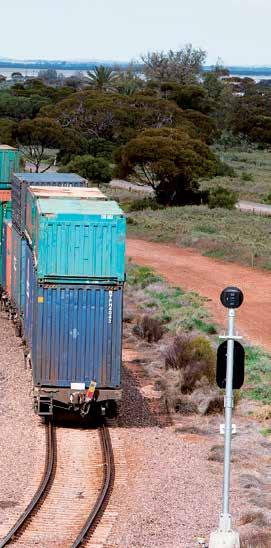
Brisbane via an inland, regional route, a hub like Pacific National’s future Parkes Logistics Terminal would be consolidating 450,000-plus shipping containers of freight from Central NSW in a single location on an annual basis.
“From Parkes, these containers can make their way to the port of Melbourne or Brisbane. The future Inland Rail will make these haulage operations even more efficient,” he said.
“The NSW Government needs to be acutely aware of these future competitive dynamics. If a freight train delayed by congestion misses a loading window for containers at Port Botany, then exporters suffer financial penalties and a loss of

goodwill from clients.”
Pacific National estimates 10 direct and indirect jobs could be lost in NSW for every 1,000 containers which gravitate away from Port Botany and towards ports in Victoria and Queensland.
Dalla Valle noted small positives for freight in NSW, such as NSW Ports investing $120 million to improve ‘on-dock’ rail infrastructure at Port Botany, but he said the government needed to get onboard to facilitate real positive development.
“There are green-shoots popping up throughout the rail supply chain,” he concluded, “it’s time for the NSW Government to work hard with industry to make them flourish.”
Dalla Valle (left) has urged the NSW government to take advantage of the opportunities presented by rail.

Sydney Trains boss Howard Collins and NSW transport minister Andrew Constance (centre left and right) seeing off the last S-set train.
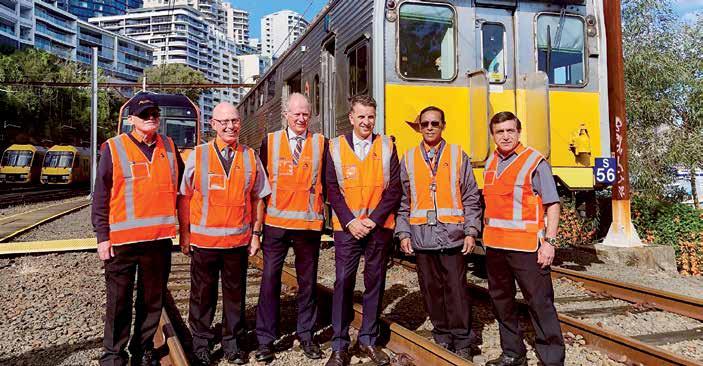
Sydney’s last S-set train retired
AFTER MORE THAN FOUR DECADES in operation the last of Sydney’s S-set train fleet has been retired, meaning all of Sydney Trains’ rollingstock is now airconditioned.
Sydney Trains boss Howard Collins and NSW transport minister Andrew Constance joined rail workers and their families on a farewell run from Central station across the Harbour Bridge to Lavender Bay on June 27, ahead of the final revenue S-set service on the T7 Olympic Park Line on June 28. Among the first double deck trains in the world, the S-sets first hit Sydney’s railways in 1972. Most of the stainless steel electric multiple units were manufactured in Granville by Comeng, while others were built in Broadmeadow by A Goninan & Co. “We’re proud of the history and evolution of railways in NSW, which is why a total of fourteen S-sets will be preserved,” Collins said. Transport Heritage NSW will Lower weekly travel cap for Opal users
THE NEW SOUTH WALES government’s new weekly cap of $50 on Opal card ticket fees came into effect on June 24. The new cap is about 20 per cent lower than the current cap of $63.20 a week, and is expected to save public transport users up to $686 a year. These savings will also extend to users of the recently-launched North West Metro, saving $563 a year for an adult customer travelling to and from Tallawong station and Central five days a week.
Examples of regular weekly commuters who could save $686 a year under the new plans include those travelling on daily commutes like Meadowbank to Barangaroo via ferry, Tuggerah to Central, and Kiama to Sutherland.
State premier Gladys Berejiklian said that the new cap would help to ease cost pressures for around 55,000 customers across NSW public transport services (including ferries).
Caps for concession holders will also be reduced as part of the plans. Opal cardbenefits such as weekly travel rewards and transfer discounts will also survive the new cap.
“We want to make public transport hold a special public farewell on July 21. Constance called the fleet’s retirement “the end of an era,” saying the S-sets had become an “icon of our railways” and had served Sydney well.
“However, our customers rightfully expect modern trains,” Constance said. “I am delighted that all 24 Waratah Series 2 trains are now in service, with another 17 on the way form next year, which is why we can now retire the S-sets.”
more affordable and that is why we are lowering the cap,” Berejiklian said. “From Monday adults will pay no more than $50 a week and the concession cap will also be reduced from $31.60 to $25 a week.” State transport minister Andrew Constance noted that individual fare prices would increase in line with inflation at 1.9 per cent, as opposed to the Independent Pricing and Regulatory Tribunal’s recommendation of a 4.2 per cent hike.
“This means catching the train, bus, ferry, metro or light rail is still a much cheaper option than driving,” he said.
George Street hosts first tram journey in over 60 years
A NEW TRAM DELIVERED AS PART of the Sydney Light Rail project has made its inaugural night test to George Street, marking the first time a tram has journeyed down the road in 61 years.
The Alstom-designed Citadis X05 tram travelled from Randwick through the Hay Street intersection and part-way along George Street to the Town Hall stop before journeying to the Light Rail maintenance depot at Lilyfield.
Testing and commissioning is expanding rapidly, with people already seeing the new trams in Randwick, Moore Park, Surry Hills, and Central Station, and to Town Hall in the coming days,” Sydney Light Rail said in a statement. “Driver training is also continuing to ramp up as we get closer to being ready for passenger services.”
The trams will be kept at the Lilyfield light rail heavy maintenance depot, which will house the trams and keep them in working order. Construction of the Lilyfield depot — which was formed from part of PHOTOGRAPHY CREDIT: ALSTOM
the former Rozelle rail yards — is now complete, with 1105 metres of track having been laid in place to service up to six trams at a time for light maintenance.
The total fleet of 60 new trams will eventually be housed in the Randwick Stabling Yard each night, with 36 trams One of Sydney’s new trams in front of Town Hall.
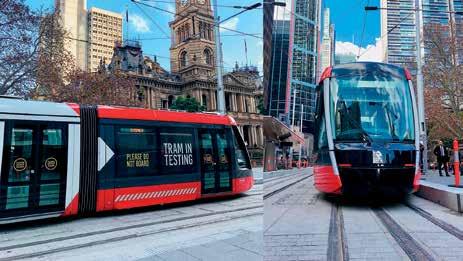
already in place at the yard so far.
The $2.1-billion Sydney CBD and South East Light Rail project encompasses a 12-kilometre route with 19 stops extending from Circular Quay to Anzac Parade. The project is expected to be completed in May 2020.
www.railexpress.com.au Light rail vehicles will soon move passengers down George street for the first time since the 1950s.
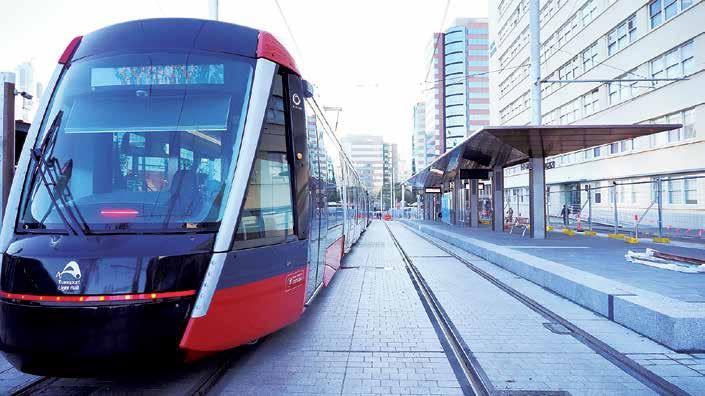
NSW commits $6.4bn to Sydney Metro West
CONSTRUCTION ON SYDNEY METRO West is to start in 2020 after the NSW Government committed $6.4 billion to build the third stage of its Metro rail program, connecting the CBD with Parramatta via a new underground route. Sydney Metro West received the funding commitment over the four-year forward estimates of the state budget, revealed in late June.
The project represents the third stage of automated metro rail to be built in Sydney, following Sydney Metro Northwest, which opened last month, and Sydney Metro City and Southwest, currently under construction.
“We always said we would build Metro West as fast as possible. This commitment in the state budget shows that when we commit to doing something, we mean business,” transport minister Andrew Constance said.
“We have worked our guts out to get the budget in a strong position and now we are able to deliver crucial rail projects like Metro West quicker than anyone thought was possible.”
New South Wales’ Sydney Metro program started with the recentlyopened Northwest line. The construction timeframe for Sydney Metro West was a major talking point prior to the state election in March, with each side was eager to promise the project sooner than their opposition.
But Constance said on June 18 the Liberals & Nationals Government was the only one capable of following through on that promise.
“Only this Government can be trusted to make [Sydney Metro West] a reality,” he said.
“Labor has promised a Metro to Western Sydney three times since the mid90s and cancelled it every time. In 2010 they were so incompetent they handed $81 million back to the Federal Government after cancelling it once again. We already have the runs on the board: we’ve opened Northwest Metro with phenomenal results and construction is well underway on Sydney Metro City & Southwest.”
The Sydney Metro West funding, which was listed at $3 billion in last year’s state budget, was part of an overall $93 billion in overall infrastructure funding included in the forward estimates.
For rail, that includes $812 million towards the New Intercity Fleet, and $38 million to progress the Regional Rail Fleet, including money to build the rail maintenance facility in Dubbo, and $3.2 billion over four years to continue the More Trains, More Services program. There’s also over $300 million for access improvements at 68 more train station, bringing total spend on the Transport Access Program to $2 billion.
$561 million is in the budget for Parramatta Light Rail, which Constance said was expected to open in 2023.
A surplus of $802 million is projected for 2018/19, with surpluses averaging $1.7 billion over the four years to 2022/23. Premier Gladys Berejiklian said the budget delivered on the Government’s promise deliver strong financial outcomes across the state.
“Only through a strong budget are we able to provide cost of living relief to households, invest unprecedented amounts in infrastructure and services, and support the most vulnerable in our community,” the premier said.
PHOTOGRAPHY CREDIT: RAIL GALLERY
